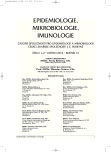Outbreaks of Viral Hepatitis E in the Czech Republic?
Authors:
Trmal Josef 1; Pavlík Ivo 2; Vašíčková Petra 2; Matějíčková Ladislava 1; Šimůnková Lenka 1; Lukš Stanislav 3; Pazderková Jana 4
Authors place of work:
KHS Ústeckého kraje, Ústí nad Labem
1; Výzkumný ústav veterinárního lékařství, v. v. i. Brno
2; Krajská veterinární správa pro Ústecký kraj, Ústí nad Labem
3; Masarykova nemocnice Ústí nad Labem
4
Published in the journal:
Epidemiol. Mikrobiol. Imunol. 61, 2012, č. 1-2, s. 15-20
Summary
Until recently, viral hepatitis E (VHE) has typically been an imported infection, related to travel to developing countries. A number of travel-unrelated VHE cases currently diagnosed in the Czech Republic. Outcomes of the epidemiological investigations of two VHE outbreaks associated with the consumption of pork and pork products at pig-slaughtering feasts are presented. Thirteen cases have been reported in the first outbreak and eight cases in the second outbreak. The epidemiological investigations are described and the experience gained in analysing suspected biological specimens is presented. The source of infection has not been identified in the first outbreak while in the other one, a link between human cases and infection in farm pigs was revealed for the first time. Although the epidemiological investigation may not always lead to the detection of the VHE source, it must be conducted in any outbreak and can only be successful when done in cooperation of the public health authorities with the veterinary health agency.
Key words:
viral hepatitis E – epidemiological investigation – source verification.
Zdroje
1. Meng, X. J. Hepatitis E virus: animal reservoirs and zoonotic risk. Vet. Mikrobiol., 2010, 140, p. 256–65.
2. Antona, D., Couturier, E., Larsen, C. Epidemiology of viral hepatitis in France. Rev. Prat., 2011, 61, 1, p. 25–27, 30–32.
3. Vivek, R., Kang, G. Hepatitis E virus infections in swine and swine handelrs in Vellore, Southern India. Am. J. Trop. Med. Hyg., 2011, 84, 4, p. 647–649.
4. Vasickova, P., Slany, M., Chalupa, P. et al. Detection and Phylogenetic Charakterization of Human Hepatitis E Virus Strains, Czech Republic. Emerging Infectious Diseases, 2011, 17, 5, p. 917–919.
5. Bächlein, C., Grummer, B. Hepatitis E – a new zoonotic disease in Germany? Berl. Munch. Tierarztl Wochenschr., 2010, 123, 5–6, p. 198–204.
6. Turner, J., Godkin Nevil, P. et al. Clinical charakteristics of hepatitis E in a “Non-Endemic” population. J. Med. Virol., 2010, 82, 11, p. 1899–1902.
7. Vishwanathan, R. Infectious hepatitis in Delhi (1955–1956): a critical study: epidemiology. Indian J. Med. Res., 1957, 45, Suppl. 1, p. 1–29.
8. Aggarwal, R. Hepatitis E: Historical, contemporary and future perspectives. J. Gastroenterol. Hepatol., 2011, 26, Suppl1, p. 72–82.
9. Colson, P., Borentain, P., Queyriaux, B. et al. Pig liver sausage as a source of hepatitis E transmission to humans. J. Infect. Dis., 2010, 202, 6, p. 825–834.
10. Weekly epidemiological record, vol. 79, 2004; 35, 3, 314–316. Hepatitis E fact sheed revised August 2004.
11. Ijaz, S., Vyse, A. J., Morgan, D. et al. Indigenous hepatitis E in England: more common it seems. J. Clin. Virol., 2009, 44, 4, p. 272–276.
12. Kamar, N., Garrouste, C., Hagsma, E. B. et al. Factors associated with chronic hepatitis in patiens with hepatitis E infection who have received solid organ transplants. Gastroenterology, 2011, 140, 5, Eupub 2011 Feb 24.
13. Tavitian, S., Perón, J. M., Hunh Mansuy, J. M. et al. Hepatitis E virus excretion can be prolonget in patiens with hematological malignancies. J. Clin. Virol., 2010, 49, 2, p. 141–144.
14. Sharma, D., Basnet, B. K., Mishra, A. K. Efect of acute hepatitis E in patients with liver cirrhosis. JNMA J Nepal Med Assoc., 2009, 48, 175, p. 226–229.
15. Kumar, A., Agarwal, R., Naik, S. R. Hepatitis E virus is responsible for dekompensation of chronic liver disease in an endemic region. Indian. J. Gastroenterol., 2004, 23, 2, p. 59–62.
16. Pourpongporn, P., Samransurp, K., Rojanasang, P. The prevalence of anti-hepatitis E in occupational risk groups. J. Med. Assoc. Thai., 2009, 92, Suppl 3, p. 38–42.
17. Zhu, F. C. Hepatitis E vaccine demonstrates complete efficacy against disease. Lancet, 2010, DOI:10.1016/S0140-6736(10)61030-6.
18. Zhu, F. C., Zhang, J., Zhang, X. F. et al. Efficacy and safety of a recombinant hepatitis E vaccine in healthy adults: a large-scale, randomised, double-blind placebo--controlled, phase 3 trial. Lancet, 2010, 376, 97, 44, p. 895–902.
19. Shrestha, M. P., Scott, R. M., Josuu, D. M. Safety and Efficacy of a Recombinant Hepatitis E Vaccine. N. Engl. J. Med., 2007, 356, p. 895–903.
20. Redakční článek. Hepatitis E vaccine: why wait? Lancet, 2010, 376, 9744, p. 845.
21. Kumar, A., Beniwal, M., Kar, P., Sharma, J. B., Murthy, N. S. Hepatitis E in pregnancy. Int. J. Gynaecol. Obstet., 2004, 85, 3, p. 240–244.
Štítky
Hygiena a epidemiológia Infekčné lekárstvo MikrobiológiaČlánok vyšiel v časopise
Epidemiologie, mikrobiologie, imunologie

2012 Číslo 1-2
- Parazitičtí červi v terapii Crohnovy choroby a dalších zánětlivých autoimunitních onemocnění
- Očkování proti virové hemoragické horečce Ebola experimentální vakcínou rVSVDG-ZEBOV-GP
- Koronavirus hýbe světem: Víte jak se chránit a jak postupovat v případě podezření?
Najčítanejšie v tomto čísle
- RNDr. Petr Petráš, CSc.
- Epidemie virové hepatitidy E v České republice?
-
30 let od popsání prvních případů AIDS – historie a současnost
Část I. - Porovnání produkce vybraných faktorů virulence Pseudomonas aeruginosa izolovaných z katétrů
